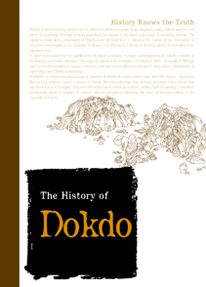- Dokdo in the East Sea
- Controversies surrounding Dokdo
- The History of Dokdo
Dokdo in the East Sea
History Knows the Truth

Historically, Dokdo has always been part of the territory of Korea. The love Koreans have for this island, like the one for the East Sea (Donghae in Korean), has never changed.
In March 2005, Japan’s Shimane Prefecture established “Takeshima Day”(Takeshima is what the Japanese call Dokdo). The object of this anniversary, celebrated every year on February 22, is to spread the notion among the Japanese people that Dokdo is part of Japan’s sovereign territory and that someday this island will be “returned” to Japan.
According to “Shimane Prefectural Notice No. 40” (Shimane-ken kokuji yonjū-gō), February 22 commemorates the fact that the Japanese named the island “Takeshima” and placed it under the jurisdiction of the Governor of the Oki Islands. February 22, 1905, was when this proclamation allowed Japan to acquire possession of Dokdo; therefore, the Japanese consider this important evidence backing their claim to the island.
We must examine in detail the year 1905, which the Japanese argue is the year Dokdo was incorporated into Japan. Many historical facts that must be unearthed are hidden within this year. Superficially seen, based on a history cobbled together from a few factual fragments, we might be able to understand Japan’s recent actions, from the declaration of “Takeshima Day” to the distortion of historical facts in Japanese textbooks of Japanese Ministry of Education, Culture, Sports, Science, and Technology.
However, history is not something that can be arbitrarily stitched together from disparate parts. Dokdo was the first piece of sovereign Korean territory absorbed by Japan in its process of invading Joseon (the name Koreans gave their Dynasty from 1392 to 1910). For Japan to insist upon possession of Dokdo is no different from its rejecting the history of the restoration of complete sovereignty to Korea. It is effectively a denial of Korea’s history of liberation from Japanese rule.
In order to comprehend the significance of Japan’s actions, a proper understanding of how its invasion of the Korean peninsula unfolded-focusing on Japan’s incorporation of Dokdo in 1905 - is required. Without such an understanding of Japan’s invasion, one will not be able to understand why Japan’s insistence of ownership over Dokdo is baseless.
Therefore, a comprehensive survey is needed of historical events before and after the Russo-Japanese War as they relate to Japan’s seizure of Dokdo. We sincerely hope that all those who love Dokdo know how important this is to bringing closure to this island as a historical problem, setting right the wrongs committed by imperial Japan’s invasion of Joseon, and to completely returning rule over all Korean territory to the Republic of Korea.








